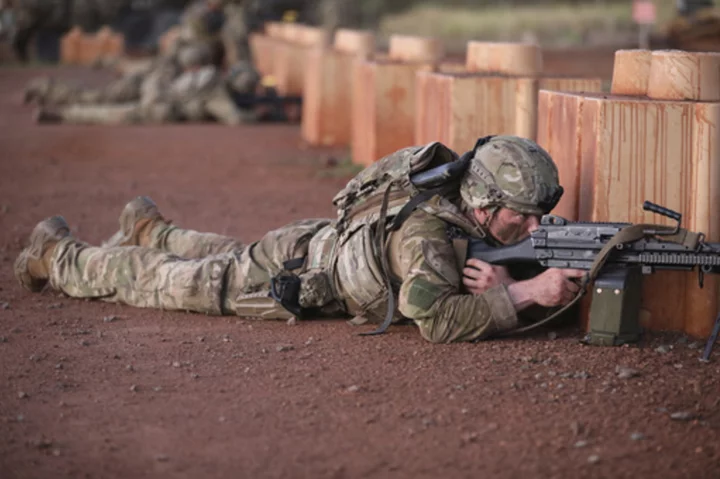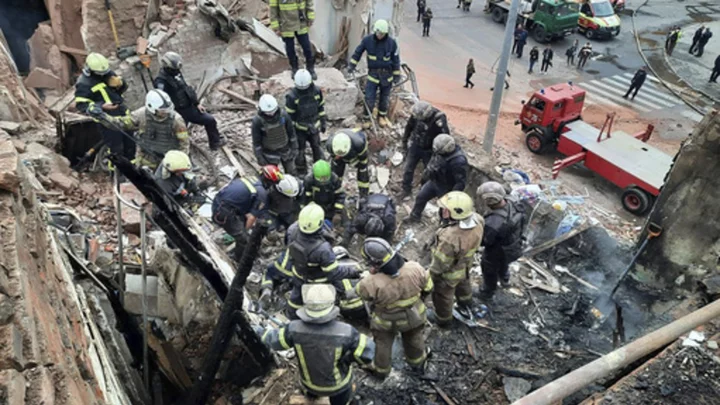BANGKOK (AP) — As Chinese missile testing in the waters around Taiwan grew increasingly aggressive in 1996, the U.S. sailed two aircraft carrier groups to the island that Beijing claims as its own, and China was forced to back down.
It employed a similar response to Hamas’ surprise attack on Israel a month ago, dispatching two carrier groups to the eastern Mediterranean in a rapid and massive show of force meant to deter other countries or Iran-backed proxy groups such as Hezbollah from joining the fight.
But what is still viable in the Mideast is increasingly less practical with China, which in 1996 had no carriers of its own and little means to threaten the American ships, but now has the world's largest navy, including three aircraft carriers, and a coastline bristling with anti-ship and anti-aircraft missiles.
Instead, ongoing exercises in Hawaii, which conclude Friday, highlight part of a new American approach to Pacific defense and deterrence, with a focus on small groups of mobile land forces operating from islands like those off China's coast.
In the exercises, the largest-scale training held in Hawaii so far, more than 5,000 troops from the 25th Infantry Division, along with units from New Zealand, Indonesia, Thailand and Britain and supported by the U.S. Air Force, have been practicing fighting in an island jungle environment against an advanced enemy force, with exercises including paratrooper drops, a long-range air assault, and re-supply by air and sea.
“All of those are examples of the importance of being able to project force here in the Pacific, which first requires seizing and holding ground and building up a base of operations where you can consolidate gains, secure and hold key infrastructure such as an airfield, and then introduce additional combat power,” said Maj. Gen. Marcus Evans, commanding general of the 25th Infantry Division, in an interview from Wheeler Army Airfield on Oahu.
While the exercises are not officially directed against a specific threat, the U.S. Department of Defense in its report last month to Congress reiterated that it considers China its “pacing challenge” as “the only competitor to the United States with the intent and, increasingly, the capacity to reshape the international order.”
Even though China's navy is now larger than that of the U.S. in terms of numbers of ships, the U.S. Navy is still more capable and has 11 carriers to China's three, among other advantages. But where China's main focus is on its nearby waters, the U.S. Navy operates globally and in the event of a Taiwan conflict, it would take time for many of its assets to get to the region.
As part of its “Operation Pathways” revamp of Pacific defense set in motion nearly a decade ago, the U.S. has been increasing its number of exercises with partners in the Indo-Pacific. It has also been re-thinking the way its soldiers and Marines operate in the first island chain off of China, which includes southwestern Japanese islands, Taiwan and the northwest Philippines, and the second island chain, which includes the Mariana Islands and the heavily fortified American territory of Guam.
Those islands give them platforms from which anti-ship and anti-aircraft missiles can be launched by mobile units that can quickly relocate to avoid counter battery fire, said Euan Graham, a defense analyst with the Australian Strategic Policy Institute.
“The U.S. already has a positional advantage by being forward deployed and having allies there, so it wants to utilize that geography in its favor,” Graham said. “And that helps the U.S. to overcome its numerical disadvantages as China's navy is continuing to expand. The U.S. has to do what it can to try and close the gap, and land forces are part of the equation.”
Beyond just being able to take and hold positions, the military has to overcome what Evans called a “tyranny of distance" in the Pacific where troops may find themselves on remote islands many hundreds of kilometers (miles) away from new supplies of water, fuel and ammunition. Among several new technologies being tested in the ongoing exercises in Hawaii are three variants of an “atmospheric water generator” to produce potable water in field conditions.
Operating from the first and second island chains would require the consent of the countries they belong to, and the U.S. has also been working hard to shore up and expand alliances in the region.
It runs large-scale training exercises with the Philippines, where earlier this year it signed an agreement to expand its use of bases, as well as with South Korea, Japan, Australia, Indonesia, Thailand and India.
The exercises provide experience in technical and procedural interoperability and also build human bonds that can be critical in times of crisis.
“We are just finishing up a defense here on the island of Oahu and watching soldiers from Indonesia, Thailand and New Zealand alongside soldiers from the United States Army dig fighting positions together, experience a crucible of privation -- that challenges, but most importantly forges relationships,” Evans said.
On the political level, U.S. Secretary of Defense Lloyd Austin is on his ninth trip to the Indo-Pacific this week with stops in India, South Korea and Indonesia, in which he is to “underscore the depth of the longstanding U.S. commitment to strengthening the Indo-Pacific’s dynamic security architecture." Austin’s travels overlap with Secretary of State Antony Blinken ’s own visits to Tokyo, Seoul and New Delhi.
Planning and training by the U.S. and its allies have not been going on in a vacuum, and China has been working hard to extend the operational capability of its navy. It has also developed so-called “carrier killer” missiles able to hit targets at long distances, and a ballistic missile capable of striking Guam.
It launched its first domestically designed a nd manufactured aircraft carrier in 2022, and that same year signed a security pact with the Solomon Islands in the Pacific, which many say could be used as a port to re-supply Chinese navy ships.
That could give the Chinese navy a better ability to operate well beyond the second island chain and disrupt American supply lines or reinforcements coming from Hawaii -- making it even more important for forward units to buy time in the event of a conflict.
Chinese President Xi Jinping has not ruled out the use of force to take Taiwan, and while the American policy on whether it would come to Taiwan's aid is that of “strategic ambiguity,” or not saying how far it is willing to go, U.S. President Joe Biden has said that Washington would intervene militarily.
With tensions rising over Taiwan, the U.S. use of the island chains could both deter China from considering an invasion, and also exact a heavy price if they tried, Graham said.
“Having long-range anti-ship missiles and long-range air defense missiles operated by small groups that are designed to be resilient, and logistically able to operate without resupply under distress, they could do a lot to deter the Chinese from ever thinking about operating in that scenario,” he said. “But if push comes to shove, they could impose a cost in terms of attrition of those forces as they move closer to Taiwan.”
Aircraft carrier groups would still likely play a large role in a conflict but would more likely be surged in and then quickly moved out, putting them at greater risk than in the past, he added.
“But then,” he said, “aircraft carriers are designed to be risked.”









